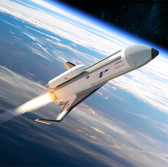 The Defense Advanced Research Projects Agency has partnered with Boeing to design, develop and test a demonstration space vehicle under DARPA’s Experimental Spaceplane program.
The Defense Advanced Research Projects Agency has partnered with Boeing to design, develop and test a demonstration space vehicle under DARPA’s Experimental Spaceplane program.
The XS-1 program seeks to build and launch a new set of hypersonic aircraft designed to provide less-expensive access to space at short notice in support of national security missions, DARPA said Wednesday.
Boeing will build a reusable unmanned spaceplane – Phantom Express – designed to field an expendable second stage to launch a 3,000-pound satellite into low-Earth orbit.
“Phantom Express is designed to disrupt and transform the satellite launch process as we know it today, creating a new, on-demand space-launch capability that can be achieved more affordably and with less risk,†Darryl Davis, president of Boeing Phantom Works, said in a statement released Wednesday.
The spaceplane will use an Aerojet Rocketdyne-built AR-22 engine designed to be reusable and run on liquid hydrogen fuel and liquid oxygen and will be equipped with a first stage that will return to Earth for use in future flights.
Boeing plans to incorporate other technology components into the technology demonstrator such as cryogenic composite propellant tanks, flight-termination systems and hybrid metal composite wings and control surfaces.
Boeing will transition to the second and third phases of the XS-1 program.
Under Phase 2, the company will design, develop and test the experimental spaceplane through 2019 and conduct 10 ground fire tests of the propulsion engine for a period of 10 days.
Boeing will perform up to 15 test flights by 2020 with a goal to send a 3,000-pound demonstration payload into orbit at a speed of Mach 10 as part of the program’s third phase.




